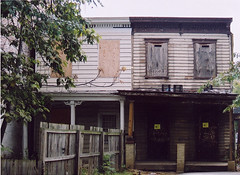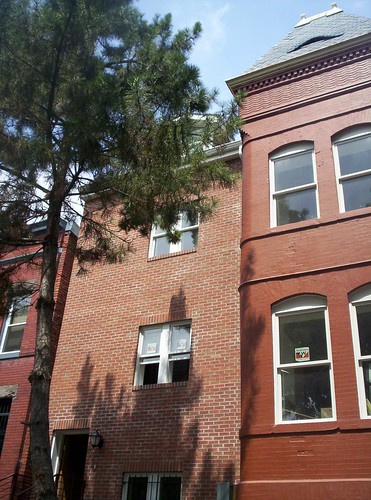Follow up to yesterday's entry about the Historic Preservation Amendment Act of 2006
 These 1876 frame rowhouses were neglected by their owner, a local church, and eventually demolished for illegal parking. Washington, DC. Photo by Peter Sefton.
These 1876 frame rowhouses were neglected by their owner, a local church, and eventually demolished for illegal parking. Washington, DC. Photo by Peter Sefton. (In response to a query.)
What bothers me is something like Jonathan Kozol's slam of his experience teaching in inner city Boston (the book, still worth reading 30+ years after publication, is called Death at an Early Age) and one of his sections on "Reading Teacher," who only taught children positive words to use to describe books. The children were unable to respond when they didn't like a book. They lacked the language.
By and large, the legislation is fine. But it was wrong to sugarcoat the impact of stripping out the demolition review protection.
What that does is put tens of thousands of buildings at risk. Because the buildings aren't historically significant at the level of an individual landmark, filing a landmark nomination will not prevent these buildings from being demolished, even though they would be significant in terms of contributing to the overall character of a "historic district."
(And there is no point in filing a nomination--the work involved is significant. Spending 100-200+ hours in a losing effort is an unsound use of precious advocacy time.)
Creating an inventory of significant buildings misses the point (as mentioned in the DCPL article), because only superlative buildings aren't at risk.
For example, maybe the Octogan House or where Ralph Bunche lived, or some of the modernist houses designed by African-American architects in Brookland would qualify--maybe 10 buildings out of close to 2,000; likely not one house north of the Capitol Hill Historic District and south of Florida Avenue--2,000 or so buildings-- would meet the criteria of an individual landmark. The same goes for entire neighborhoods such as Trinidad or Woodridge. Hill East too. A handful of a couple thousand buildings might qualify at the level of an individual landmark.
Death of neighborhood character, maybe not by 1,000 cuts, but by demolition after demolition, will make a significant difference in the sense of completeness and wholeness of a neighborhood and its architectural and historic character.
And again, it tears at the fabric of three of the most significant competitive advantages possessed by the City of Washington--architecture, history, and urban design.
That's why this provision in the law was so important, and why I advocated so strenuously for its creation and inclusion within the law.
___________
The buildings in the photo above, at 819-821 7th Street NE, were neglected for years by the Pilgrim Baptist Church, whose intent was always to tear these buildings down in favor of a parking lot, which has since been created, illegally, without action by the Department of Consumer and Regulatory Affairs.
The nomination to protect these buildings, at the time, two of a small and decreasing number of frame buildings extant in the area north of the Capitol Hill Historic District and within the "Old City" of Washington designed by L'Enfant, was strong and the presentation to the Historic Preservation Review Board was excellent, but it wasn't enough. The nomination wasn't sustained, the Church wasn't willing to negotiate (I think their long term plan is to tear down the rest of the buildings they own around this area and eventually create a big "Family Life Center" along the lines of the one by Shiloh Baptist on 9th Street NE, likely named after the pastor...) and the buildings came down.
(I can't seem to find the illegal parking lot photo, but I'll insert that into the entry later in the day.)
This was one of the many instances that sensitized me about the issue, and the necessity of having demolition protections in order to preserve neighborhood character. (Note: people are attracted to urban living in Washington in large part because of the stock of historic buildings in walkable neighborhoods. When you tear down the historic buildings, you diminish a neighborhood's attractiveness, and provide fewer reasons for people to move in and invest in the city.)
The problem is that the typical "developer" working within a neighborhood like H Street or Trinidad or Brookland is a bottom feeder, completely driven by revenue, and likely with little training in architecture and a lack of knowledge about historic buildings, architectural styles, etc.
To them, it's about "aesthetics" and "aesthetics" are merely a matter of "opinion." It's all about getting in and out as cheaply as possible. The idea of craftsmanship in construction, in building a house meant to last and to fit in contextually within a block and a neighborhood--these are alien concepts. If a house looks suburban, well isn't that how most newly constructed houses look in the United States, because most houses are built in the suburbs?
 This house on the 1300 block of Maryland Avenue NE, being made into condominiums, with an addition, is a perfect example.
This house on the 1300 block of Maryland Avenue NE, being made into condominiums, with an addition, is a perfect example. I apologize that the photo isn't the greatest. But the building on the left demonstrates the point. The rhythm of the building compared to every other house on the block is wrong. The floors don't match up between the buildings on either side. Neither do the windows. Nor the cornices. The setback is an issue, and so is the failure to use the party wall and connect to the house on the west--instead there is a narrow walkway.
The house (three condominiums) looks cheap and will look cheap forever. In a weaker real estate market, people won't just buy any thing built with a for sale sign slapped on. And the appreciation potential (a significant factor for people in building their portfolio of household wealth) is significantly reduced.
The aggravating, if not "tragic" aspect is that for but a few thousand more dollars, this building could have been constructed in a historically sympathetic fashion--but there is no design review in non-designated neighborhoods, and no way to "encourage" builders to construct quality buildings instead of junk.
Demolition review + Design review are essential tools, necessary for the stablization and extension of
neighborhood character and livability.
Index Keywords: historic-preservation



0 Comments:
Post a Comment
<< Home